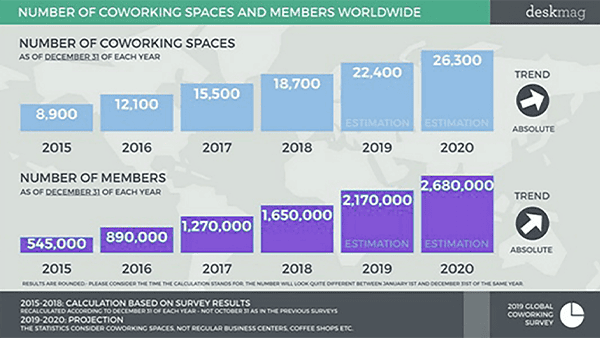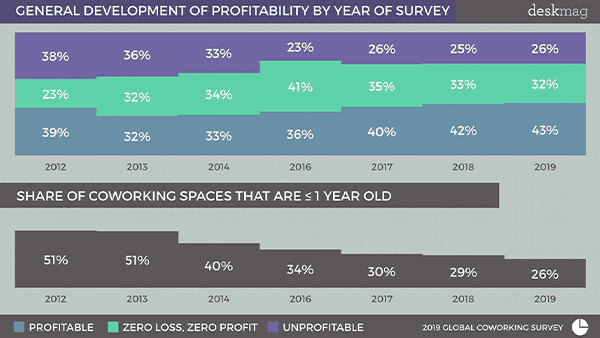Global Coworking Survey 2019: Things That Can’t Be Missed
.png&w=3840&q=75)
Summary – Generally, coworking is perceived as a privilege in the corporate world, as it redefines the traditional concept of workspaces, and brings more work-life balance to employees. But, according to the Global Coworking Survey in 2019, it is contributing to the future of the work and productivity of your employees.
We know what you must be thinking. Not another of the elaborate survey discussions, right? And what’s so special about it anyway? Well, you’d be wrong both the times – because the Global Coworking Survey is by-far the coworking industry’s gold measure in understanding the growing inclination of employees and freelancers’ towards coworking; and yields pretty striking results. So, if you have been noticing too many new co-working spaces springing in your area, or find those spaces grow more crowded and chic over time, you now know where it’s all coming from.
Carried out by Deskmag, a leading digital magazine that talks about the current coworking culture across the world, the Global Coworking Survey is known for its numerous participants worldwide (in 2019, it was more than 1900). We know right, what more can a survey reveal about coworking that you already haven’t heard yet? To understand the fundamentals of coworking, it is crucial that you come from a bird-eye view of the scenario and then discover the much deeper reasons for things to be the way they are – and this is where the Global Coworking Report comes in.
Flexibility
The 2019 Global Coworking Survey reported the following:

Credits: Naiop.org
It was found that the number of coworking spaces and coworkers across the globe has seen a tremendous rise (more than 3x than that of 2015) in the last five years. While the numbers may seem harmless on paper, it means an end to conventional/traditional offices. Think about it. No more cubicles, office politics, slogging till the day ends for getting some foosball time. Who wouldn’t like that?
Factors Responsible for the Coworking Boom:
On the surface, there can be several reasons why coworking has grown exponentially across the world. One of these reasons can be:
It attracts and retains new talent pools: According to the science of the human mind, the more people collaborate and interact, the more productivity you can churn out of your employees. In the past decade, as coworking has evolved from being a mere meeting point of work and leisure to a niche interactive environment where people from the related line of work come together to produce meaningful work, it does tap into the modern workability interests of millennials and baby boomers across the world.
Taking from this trend, many established brand operators worldwide have formulated a hybrid working model that thrives on interaction, only to be limited by its office ground rules. Such scenarios had led them to lose many valued employees, especially the ones who prefer refined work quality.
But when digging deeper, the growing inclination towards coworking is closely linked to flexibility, in many terms. Most importantly, it’s not just limited to the employer, but to all parties, here’s how:
- Flexibility in terms of Occupancy Cost (Employers’ perspective)
For a small startup, coworking provides them access to a class A environment (complete with network peripherals and other technical requirements) with bare minimum expenses, which otherwise would have been at least 2x more if it were to lease a space for making its office premises (excluding the peripherals).
- Flexibility in terms of Making More (Brokers’ perspective)
Similarly, since coworking spaces worldwide pay 10% of their earnings as brokerage fees annually, on average; brokers can actually optimize opportunities accordingly. Plus, with constricted contracts the coworking spaces are more accessible to clients big and small, having increased chances of expanding contracts according to their will once they settle in and have custom-made workstations. In other words, $200 per sq.ft. compared to the $70 per sq. ft. in a traditional office building in Manhattan.
- Flexibility in terms of workability (Employees’ perspective)
Employees have often agreed to witness an increase in their engagement and concentration for the job at hand when they are in open spaces. Unlike remote work that can get pretty lonely, workers here feel a strong sense of community and thrive well in shared ideas, support, and ownership. It keeps them motivated and involved with their work in the right way.
Profitability & Revenue Streams:
Similarly, when it comes to profitability, the survey reports the following:

Credits: SquareSpace
While 40% may seem a fairly small number on paper, it means a large number of spaces in reality. But, that’s not all. In fact, the numbers are low because coworking is growing at an aggressive rate, and it is estimated by this growth rate, the profitability of coworking spaces will rise up to 70% worldwide. What exactly is causing the stir?
Since coworking is the new normal where people belong from all ages, industries, tier-II, and tier-III cities are coming together to work collaboratively, companies are inclining towards coworking spaces because of its affordability and ease. However, not all coworking spaces (read business models) are profitable. Some of the most profitable setups include:
Open Spaces: Here coworking spaces offer open desks, lounges, conference rooms, dedicated desks, lockers to members who need a safe space to store their belongings, and some privacy at work. Dedicated seating may also apply to coworkers who don’t like to chase their seats as they start their day.
Coworking & Office Spaces: It works for members for whom the open spaces may not work. Here, you allocate private access to members’ very own lockable workspace.
Suite Office Spaces: Mainly preferred by smaller and medium companies, it particularly caters when members need the best of both worlds (from the traditional office spaces and the coworking community).
Now, the question may arise; how exactly do coworking spaces make revenue?
The most common channel would be that of leasing large spaces to enterprises that can look after the organization and management of resources of the assigned space, as well as rent out the free space to others. Apart from it, there can be a multitude of revenue streams for coworking spaces, some of them include:
- Membership Charges:
Coworking spaces can charge rented spaces based on hourly, daily, weekly, monthly, quarterly, or annually as the base fare, per member. They also offer special discount rates, loyalty points to retain their members.
- Custom Membership Packages:
Apart from the no-package, pay-per-use plan, coworking spaces can charge their members according to the chosen membership packages which may be personalized based on your requirements. Here, the fares cover average visitor charges, basic and advanced amenities, and can be calculated as a gross of all expenses.
- Charging for Renting Facilities and Equipment
Coworking spaces may also charge for private cabins, equipped with standalone communication channels, scanners, audio and video gadgets, etc.
What Does the Future Hold?
The Global Coworking Survey 2019 also points to the expansion plans of the majority of all coworking operators worldwide by 30%. More than 86% tell about the steady rise of members last year, and as competition rises members move to other coworking spaces to make the most of their functionalities, services, as well as geographical positions.
While Deskmag’s Global Coworking Survey does provide evidence (in figures) of the rise, income, and future outlook of coworking spaces; the current pandemic has definitely hit the coworking industry hard. With each passing day, as more and more operators adapt to newer, transparent, hygienic protocols to bring back its members, the aftermath of COVID-19 looks promising for coworking only if it stems from minimum physical exposure to other members for a safer working environment. At Zioks, we provide ergonomically-sound, clean, and personalized shared office space in Kolkata to our select members at a time. Drop in to say a ‘Hi’ to us!


